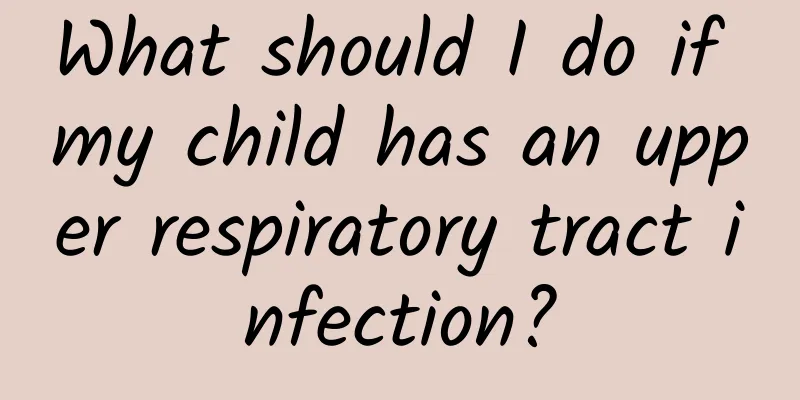What should I do if my child has an upper respiratory tract infection?

|
Pediatric upper respiratory tract infection, also known as "upper respiratory infection" or "cold", is an acute infection of the upper respiratory tract caused by various viruses and bacteria. It is the most common disease in children. The main sites of upper respiratory tract infection are the nose, nasopharynx and pharynx of children. It can be diagnosed as acute pharyngitis, acute tonsillitis, acute rhinitis, etc. according to the different sites of infection. They need to be subdivided clinically. About 90% of upper respiratory tract infections start with viral infections. Due to the influence of children themselves or external factors, they will recur and aggravate the condition, causing pneumonia, bronchitis, etc., and the course of the disease may also be prolonged. 1. How to diagnose upper respiratory tract infection in children? Upper respiratory tract infections in children can be divided into general upper respiratory tract infections and special types of upper respiratory tract infections, and their diagnostic points are different. 1. General upper respiratory tract infection The course of an upper respiratory tract infection is usually 3-4 days and it is a self-limiting disease. 1. The main symptoms are sudden onset in infants and young children, with common symptoms including nasal congestion, runny nose, sneezing, throat discomfort, cough, sputum, fever, etc. Some children may experience nausea, vomiting, loss of appetite, rash, etc. 2. The symptoms of children's illness include congestion in the pharynx and swollen tonsils. Some children may also have swollen cervical or submandibular lymph nodes. People infected with enterovirus may develop rashes of different forms. 3. Laboratory examinations show that the blood routine of virus-infected patients is normal, the ratio of white blood cells to neutrophils is decreased, and the lymphocyte ratio is relatively increased; in cases of viral and bacterial infection, the total white blood cell count and the ratio of neutrophils may increase. 4. In clinical practice, general upper respiratory tract infections need to be differentiated from diseases such as influenza, allergic rhinitis, and early stages of acute infectious diseases. 2. Special types of upper respiratory tract infections 1. Herpetic pharyngitis: It is most common in summer and autumn. The pathogen is Coxsackie virus group A, and the onset is acute. Symptoms include sore throat, fever, salivation, anorexia, nausea, vomiting, etc. Physical examination shows herpes on the mucous membrane of the pharyngeal palate arch, soft palate, and uvula, which rupture and form ulcers. The course of the disease is about one week. 2. Pharyngococcygeal fever: It can be prevalent in spring and summer and is caused by adenovirus. In addition to fever and sore throat, clinical symptoms include follicular conjunctivitis and swollen preauricular lymph nodes. Some may be accompanied by gastrointestinal symptoms. The course of the disease is 1-2 weeks. 2. How to treat upper respiratory tract infection in children? 1. General treatment. The child needs to get enough rest, drink plenty of water, and eat some nutritious foods. Do a good job of respiratory isolation, keep the respiratory tract unobstructed, and pay attention to the prevention of complications. 2. Anti-infection treatment. Acute upper respiratory tract infections are mostly viral infections, and antibiotics are not recommended. Some Chinese medicine preparations have certain effects. If it is a bacterial infection or a viral infection followed by a bacterial infection, antibiotics can be used for treatment. Commonly used antibiotics include penicillins, cephalosporins, and macrolides. It is recommended to use them under the guidance of a doctor. 3. Symptomatic treatment. When the child has a high fever, antipyretics such as acetaminophen and ibuprofen can be used. Physical cooling can also be used, such as cold compresses or warm water baths. Those who have febrile convulsions can be treated with sedation and anticonvulsions. Those with nasal congestion can be given decongestants as appropriate, and throat lozenges can be given for sore throats. 3. How to prevent upper respiratory tract infections in children? 1. In daily diet, give children more fresh fruits and vegetables to increase vitamin intake and improve children's immunity, so as to help children resist foreign viruses or bacteria and effectively prevent upper respiratory tract infections. Make sure children drink more water to keep the respiratory tract moist and reduce infection. 2. Pay attention to weather changes, add or remove clothes appropriately, and avoid wearing too much or too little to avoid catching a cold. 3. During the high incidence season of upper respiratory tract infections, or when there are people with upper respiratory tract infections around you, children should be kept away from contact as much as possible and should avoid going to crowded public places. 4. You need to see a doctor promptly after becoming ill in order to clarify the condition, diagnose and treat it. 5. Encourage children to increase physical exercise, strengthen outdoor activities, get more sun exposure, and improve their disease resistance. 6. Keep the room clean and ventilated, maintain a good living environment, and prevent viral and bacterial infections. Pediatric respiratory infections can occur throughout the year. When an illness occurs, it is best to go to the hospital for professional diagnosis and treatment. For some children with recurrent respiratory infections, it is necessary to actively find the cause and pay attention to whether the child has abnormal immune function in order to take effective treatment. |
Recommend
What are the dangers of excessive masturbation in women?
Masturbation is a very normal physiological pheno...
Can I eat bitter melon during menstruation?
As we all know, menstruation is a very special an...
Fetal death due to car shaking
Finally pregnant, but because of some trivial mat...
Breast enhancement and beauty soup, drink it to get an ageless face
Aging is a normal part of human nature, but peopl...
Cancer is contagious, but not in the way you think
"Viral" and "contagious" canc...
What causes hemorrhoids in girls?
If you are embarrassed when talking about hemorrh...
What are the effects of endometriosis?
Endometriosis lesions are actually a disease that...
Signs of menstruation coming soon during lactation
After giving birth, women will have a period of u...
What are the causes of sore throat? Beware of acute laryngitis
Pharyngitis is a typical ear, nose and throat dis...
What are the symptoms of menopause for a 47-year-old woman?
Women generally enter menopause between the ages ...
Can pregnant women eat jute leaves?
Today, the younger generation of young couples ar...
Children's urination is a "small matter"
Author: Yu Xiaoning Children's Hospital Affil...
What is the effect of interventional treatment for uterine fibroids?
Uterine fibroids are a gynecological disease that...
Is yellowish and transparent vaginal discharge normal?
Women's secretions are rich in glycogen, whic...









